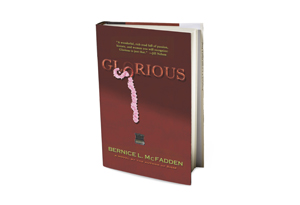Reading Questions for Glorious
Warning: May contain spoilers

Photo: Jeffrey Westbrook/Studio D
1. Why did the author choose to name the protagonist Easter? How does her name relate to the story?
2. Describe the setting of Glorious. Why might an author have chosen to write about this time period and these places and events?
3. Why do you think Easter continuously chooses to walk away from people and places and situations instead of confronting them head-on?
4. McFadden chooses to incorporate historical figures in a fictional context. Who does she include? Does her portrayal of them match historical accounts?
5. What does the historical narrative of Glorious reveal about contemporary society?
6. The quest for love and acceptance is a key theme of Glorious. How does the author use the cast of characters to highlight the complexity of this quest?
7. The characters in Glorious are from different classes, backgrounds, and ethnic groups but they share many commonalities. What are some of those shared characteristics?
8. What imagery does the author use in the prologue to set the scene? Does this imagery appear again in the story?
9. Why is Easter attracted to Mama Rain and then later, Getty Wisdom? Do the two have common qualities that draw Easter to them? Did her husband, Colin Gibbs, have any of those same qualities?
10. In Harlem, Easter tells Rain that she was writing to "Keep a grip on life." At the end of the book though, when Easter has given up writing, does this mean that she has also given up on life?
11. The author presents many representations of friendship and relationships. Describe some. Which are most successful? Why do you think these relationships are able to endure?
12. The story begins and ends in Waycross, Georgia. Why did the author choose to close the story in a place that held so many bad memories for Easter? Is there symbolism in this?
13. Does Easter Bartlett obtain justice? What does she sacrifice in the process?
14. Why do you think that the author chose the quotations by T.S. Eliot and Zora Neale Hurston as the novel's epigraphs? What do they signify?
Read O's review
Get more reading guides
2. Describe the setting of Glorious. Why might an author have chosen to write about this time period and these places and events?
3. Why do you think Easter continuously chooses to walk away from people and places and situations instead of confronting them head-on?
4. McFadden chooses to incorporate historical figures in a fictional context. Who does she include? Does her portrayal of them match historical accounts?
5. What does the historical narrative of Glorious reveal about contemporary society?
6. The quest for love and acceptance is a key theme of Glorious. How does the author use the cast of characters to highlight the complexity of this quest?
7. The characters in Glorious are from different classes, backgrounds, and ethnic groups but they share many commonalities. What are some of those shared characteristics?
8. What imagery does the author use in the prologue to set the scene? Does this imagery appear again in the story?
9. Why is Easter attracted to Mama Rain and then later, Getty Wisdom? Do the two have common qualities that draw Easter to them? Did her husband, Colin Gibbs, have any of those same qualities?
10. In Harlem, Easter tells Rain that she was writing to "Keep a grip on life." At the end of the book though, when Easter has given up writing, does this mean that she has also given up on life?
11. The author presents many representations of friendship and relationships. Describe some. Which are most successful? Why do you think these relationships are able to endure?
12. The story begins and ends in Waycross, Georgia. Why did the author choose to close the story in a place that held so many bad memories for Easter? Is there symbolism in this?
13. Does Easter Bartlett obtain justice? What does she sacrifice in the process?
14. Why do you think that the author chose the quotations by T.S. Eliot and Zora Neale Hurston as the novel's epigraphs? What do they signify?
Read O's review
Get more reading guides



